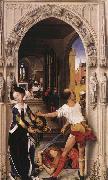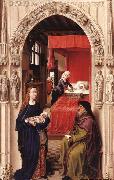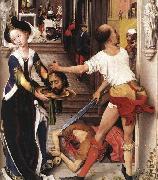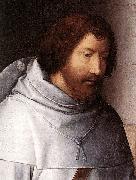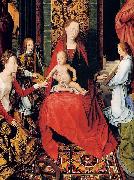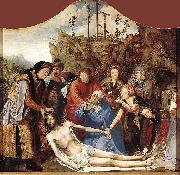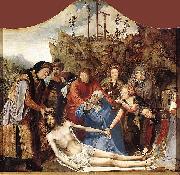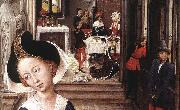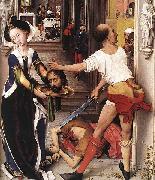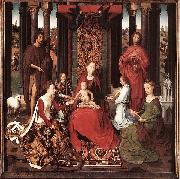Wholesale Oil Painting No Minimum |
|||||||||||
|
|
|||||||||||

|
|||||||||||
|
|
|
||||||||
MASSYS, QuentinFlemish Northern Renaissance Painter, ca.1465-1530 Quentin Massys, also spelled Matsys or Metsys, was born in Louvain, the son of a blacksmith. He is traditionally thought to have been trained in that craft by his father. Art in Louvain while Massys was growing up was dominated by Dirk Bouts. Massys became a member of the painters' guild in Antwerp in 1491 and died there in 1530. He represented a current of painting that flourished in Antwerp at this time of its sudden new prosperity. Erwin Panofsky (1953) described this trend, "archaism of around 1500," as "a prelude to, in fact a fact of, the Renaissance in Netherlandish painting," which prevailed in the southern Netherlands. The monumental Enthroned Madonna (Brussels), an early work by Massys, has features recalling both Robert Campin and Jan van Eyck. The central panel of Massys' imposing St. Anne Altarpiece, or the Holy Kinship (Brussels), which was commissioned for the church of St-Pierre in Louvain in 1507 and signed and dated 1509, has a prototype in the Holy Kinship of Geertgen tot Sint Jans. Even the physical types and costumes in Massys' version refer to Geertgen's. But Massys placed his rhythmically balanced figure groups in a domed, arcaded loggia that in architectural style appears to be reaching for a Renaissance vocabulary it cannot quite attain; certainly the architecture evokes a later period than that represented by the Gothic throne of the Enthroned Madonna. The calm and restraint of the St. Anne Altarpiece are replaced by heightened emotional expression in the next important painting by Massys that can be firmly dated, the Deposition triptych (Antwerp). This was commissioned in 1508 by the guild of joiners in Antwerp for their chapel in the Cathedral; Massys completed the composition in 1511. It was inspired by Rogier van der Weyden's great Deposition, which was in the church of St-Pierre in Louvain in Massys' time, and also quotes from Rogier's Entombment. Massys painted genre subjects, possibly with emblematic meaning, such as A Money Changer and His Wife, which belonged to a Netherlandish tradition that maintained its popularity right through the 17th century. In portraiture he made significant contributions. His pair of portraits of Erasmus and Petrus Aegidius, painted in 1517 for Sir Thomas More, set the pattern for representations of the scholar in his study. |
||||||||
|
|
||||||||
St John Altarpiece
St John Altarpiece Painting ID:: 32405 |
1507-08
Oil on wood, 260 x 504 cm 1507-08 Oil on wood, 260 x 504 cm |
|||||||
|
|
||||||||
WEYDEN, Rogier van derNetherlandish Northern Renaissance Painter, ca.1400-1464 major early Flemish master, known also as Roger de la Pasture. He is believed to have studied with Robert Campin. His early works also show the influence of Jan van Eyck. Van Eyck, however, had been a master at objective rendering of detail, whereas Roger in his work portrayed emotions with an assurance that has not been surpassed. His ability to depict piety is reflected in the early masterpiece Descent from the Cross (c.1435; Prado); he depicted with significant restraint the profound grief of the mourners grouped around the tragic figure of Jesus. His composition strongly affected later representations of the theme. Roger became City Painter in Brussels in 1436. He then produced a series of undated altarpieces including the Last Judgment (hospital, Beaune), the Braque Triptych (Louvre), Crucifixion with Donors (Vienna), and Adoration of the Magi (Berlin), which vary in execution from a stress on sumptuous details to a more sculptural rendering of the figures. Roger is believed to have made a pilgrimage to Italy in the holy year 1450. Whether this supposed excursion had any effect on his style is much debated. It has been shown that his Entombment (Uffizi) bears an affinity to the Tuscan treatment of the subject, particularly by Fra Angelico, and that Roger's Virgin and Child with Saints (Frankfurt) has a strong resemblance to the Italian religious art of the day. His style is, however, highly individual. His religious paintings and his portraits are characterized by a straightforward monumentality. The portraits, such as that of a young lady (National Gall. of Art, Washington, D.C.) and of Francesco d'Este (Metropolitan Mus.) exhibit a simple clarity of contour and psychological penetration. Other notable works are his St. Luke Painting the Virgin, of which a version or replica is in the Museum of Fine Arts, Boston, the Crucifixion |
||||||||
|
|
||||||||
|
|
St John Altarpiece
St John Altarpiece Painting ID:: 51168 |
1455-60
Oil on oak panel,
77 x 48 cm 1455-60 Oil on oak panel, 77 x 48 cm |
||||||
|
|
||||||||
WEYDEN, Rogier van derNetherlandish Northern Renaissance Painter, ca.1400-1464 major early Flemish master, known also as Roger de la Pasture. He is believed to have studied with Robert Campin. His early works also show the influence of Jan van Eyck. Van Eyck, however, had been a master at objective rendering of detail, whereas Roger in his work portrayed emotions with an assurance that has not been surpassed. His ability to depict piety is reflected in the early masterpiece Descent from the Cross (c.1435; Prado); he depicted with significant restraint the profound grief of the mourners grouped around the tragic figure of Jesus. His composition strongly affected later representations of the theme. Roger became City Painter in Brussels in 1436. He then produced a series of undated altarpieces including the Last Judgment (hospital, Beaune), the Braque Triptych (Louvre), Crucifixion with Donors (Vienna), and Adoration of the Magi (Berlin), which vary in execution from a stress on sumptuous details to a more sculptural rendering of the figures. Roger is believed to have made a pilgrimage to Italy in the holy year 1450. Whether this supposed excursion had any effect on his style is much debated. It has been shown that his Entombment (Uffizi) bears an affinity to the Tuscan treatment of the subject, particularly by Fra Angelico, and that Roger's Virgin and Child with Saints (Frankfurt) has a strong resemblance to the Italian religious art of the day. His style is, however, highly individual. His religious paintings and his portraits are characterized by a straightforward monumentality. The portraits, such as that of a young lady (National Gall. of Art, Washington, D.C.) and of Francesco d'Este (Metropolitan Mus.) exhibit a simple clarity of contour and psychological penetration. Other notable works are his St. Luke Painting the Virgin, of which a version or replica is in the Museum of Fine Arts, Boston, the Crucifixion |
||||||||
|
|
||||||||
|
|
St John Altarpiece
St John Altarpiece Painting ID:: 63861 |
1455-60 Oil on oak panel, 77 x 48 cm Staatliche Museen, Berlin The left panel depicts the Naming of John the Baptist. Elisabeth lies in bed in the background after giving birth, while the pregnant Mary, the future mother of Jesus, brings the newborn child to his father Zacharias. Zacharias had been struck dumb for his doubts when an angel told him, during service in the temple, that he was to be the father of a son (this scene is shown in the lowest archivolt relief on the left). He therefore has to write down the name of the child. Mary, as the more important saint, is distinguished from Zacharias and Elisabeth by her aureole. The side panels of the St John Altarpiece do not merely show the beginning and end of the Baptist's earthly life. The parallels between the pictorial motifs also express moral conflict. On the left, the chaste Virgin Mary holds the newborn baby in her arms; she and Zacharias are looking at one another gravely, aware of the significance of the event.Artist:WEYDEN, Rogier van der Title: St John Altarpiece (left panel) Painted in 1401-1450 , Flemish - - painting : religious 1455-60 Oil on oak panel, 77 x 48 cm Staatliche Museen, Berlin The left panel depicts the Naming of John the Baptist. Elisabeth lies in bed in the background after giving birth, while the pregnant Mary, the future mother of Jesus, brings the newborn child to his father Zacharias. Zacharias had been struck dumb for his doubts when an angel told him, during service in the temple, that he was to be the father of a son (this scene is shown in the lowest archivolt relief on the left). He therefore has to write down the name of the child. Mary, as the more important saint, is distinguished from Zacharias and Elisabeth by her aureole. The side panels of the St John Altarpiece do not merely show the beginning and end of the Baptist's earthly life. The parallels between the pictorial motifs also express moral conflict. On the left, the chaste Virgin Mary holds the newborn baby in her arms; she and Zacharias are looking at one another gravely, aware of the significance of the event.Artist:WEYDEN, Rogier van der Title: St John Altarpiece (left panel) Painted in 1401-1450 , Flemish - - painting : religious |
||||||
|
|
||||||||
WEYDEN, Rogier van derNetherlandish Northern Renaissance Painter, ca.1400-1464 major early Flemish master, known also as Roger de la Pasture. He is believed to have studied with Robert Campin. His early works also show the influence of Jan van Eyck. Van Eyck, however, had been a master at objective rendering of detail, whereas Roger in his work portrayed emotions with an assurance that has not been surpassed. His ability to depict piety is reflected in the early masterpiece Descent from the Cross (c.1435; Prado); he depicted with significant restraint the profound grief of the mourners grouped around the tragic figure of Jesus. His composition strongly affected later representations of the theme. Roger became City Painter in Brussels in 1436. He then produced a series of undated altarpieces including the Last Judgment (hospital, Beaune), the Braque Triptych (Louvre), Crucifixion with Donors (Vienna), and Adoration of the Magi (Berlin), which vary in execution from a stress on sumptuous details to a more sculptural rendering of the figures. Roger is believed to have made a pilgrimage to Italy in the holy year 1450. Whether this supposed excursion had any effect on his style is much debated. It has been shown that his Entombment (Uffizi) bears an affinity to the Tuscan treatment of the subject, particularly by Fra Angelico, and that Roger's Virgin and Child with Saints (Frankfurt) has a strong resemblance to the Italian religious art of the day. His style is, however, highly individual. His religious paintings and his portraits are characterized by a straightforward monumentality. The portraits, such as that of a young lady (National Gall. of Art, Washington, D.C.) and of Francesco d'Este (Metropolitan Mus.) exhibit a simple clarity of contour and psychological penetration. Other notable works are his St. Luke Painting the Virgin, of which a version or replica is in the Museum of Fine Arts, Boston, the Crucifixion |
||||||||
|
|
||||||||
|
|
St John Altarpiece
St John Altarpiece Painting ID:: 63871 |
1455-60 Oil on oak panel Staatliche Museen, Berlin The body of the executed man is part of the foreground group, and the executioner can set his sword against John's right shoulder, shown in a flat plane. At the same time, however, two mourners who belong to the background are placed directly above the cellar stairs where the dead man is lying, and a figure diminished to about one-third of the size of the foreground figures appears to be standing only a little farther back from them.Artist:WEYDEN, Rogier van der Title: St John Altarpiece (detail) Painted in 1401-1450 , Flemish - - painting : religious 1455-60 Oil on oak panel Staatliche Museen, Berlin The body of the executed man is part of the foreground group, and the executioner can set his sword against John's right shoulder, shown in a flat plane. At the same time, however, two mourners who belong to the background are placed directly above the cellar stairs where the dead man is lying, and a figure diminished to about one-third of the size of the foreground figures appears to be standing only a little farther back from them.Artist:WEYDEN, Rogier van der Title: St John Altarpiece (detail) Painted in 1401-1450 , Flemish - - painting : religious |
||||||
|
|
||||||||
WEYDEN, Rogier van derNetherlandish Northern Renaissance Painter, ca.1400-1464 major early Flemish master, known also as Roger de la Pasture. He is believed to have studied with Robert Campin. His early works also show the influence of Jan van Eyck. Van Eyck, however, had been a master at objective rendering of detail, whereas Roger in his work portrayed emotions with an assurance that has not been surpassed. His ability to depict piety is reflected in the early masterpiece Descent from the Cross (c.1435; Prado); he depicted with significant restraint the profound grief of the mourners grouped around the tragic figure of Jesus. His composition strongly affected later representations of the theme. Roger became City Painter in Brussels in 1436. He then produced a series of undated altarpieces including the Last Judgment (hospital, Beaune), the Braque Triptych (Louvre), Crucifixion with Donors (Vienna), and Adoration of the Magi (Berlin), which vary in execution from a stress on sumptuous details to a more sculptural rendering of the figures. Roger is believed to have made a pilgrimage to Italy in the holy year 1450. Whether this supposed excursion had any effect on his style is much debated. It has been shown that his Entombment (Uffizi) bears an affinity to the Tuscan treatment of the subject, particularly by Fra Angelico, and that Roger's Virgin and Child with Saints (Frankfurt) has a strong resemblance to the Italian religious art of the day. His style is, however, highly individual. His religious paintings and his portraits are characterized by a straightforward monumentality. The portraits, such as that of a young lady (National Gall. of Art, Washington, D.C.) and of Francesco d'Este (Metropolitan Mus.) exhibit a simple clarity of contour and psychological penetration. Other notable works are his St. Luke Painting the Virgin, of which a version or replica is in the Museum of Fine Arts, Boston, the Crucifixion |
||||||||
|
|
||||||||
|
|
St John Altarpiece
St John Altarpiece Painting ID:: 63872 |
1455-60 Oil on oak panel Staatliche Museen, Berlin As a lascivious worldly beauty, Salome wears a magnificent dress in the fashion of French princesses, with exotic decorative items including the pointed head-dress. The background shows the scene of the banquet in which Salome's mother, Herodias, stabs the decapitated head of the Baptist in her hatred for him.Artist:WEYDEN, Rogier van der Title: St John Altarpiece (detail) Painted in 1401-1450 , Flemish - - painting : religious 1455-60 Oil on oak panel Staatliche Museen, Berlin As a lascivious worldly beauty, Salome wears a magnificent dress in the fashion of French princesses, with exotic decorative items including the pointed head-dress. The background shows the scene of the banquet in which Salome's mother, Herodias, stabs the decapitated head of the Baptist in her hatred for him.Artist:WEYDEN, Rogier van der Title: St John Altarpiece (detail) Painted in 1401-1450 , Flemish - - painting : religious |
||||||
|
|
||||||||
MASSYS, QuentinFlemish Northern Renaissance Painter, ca.1465-1530 Quentin Massys, also spelled Matsys or Metsys, was born in Louvain, the son of a blacksmith. He is traditionally thought to have been trained in that craft by his father. Art in Louvain while Massys was growing up was dominated by Dirk Bouts. Massys became a member of the painters' guild in Antwerp in 1491 and died there in 1530. He represented a current of painting that flourished in Antwerp at this time of its sudden new prosperity. Erwin Panofsky (1953) described this trend, "archaism of around 1500," as "a prelude to, in fact a fact of, the Renaissance in Netherlandish painting," which prevailed in the southern Netherlands. The monumental Enthroned Madonna (Brussels), an early work by Massys, has features recalling both Robert Campin and Jan van Eyck. The central panel of Massys' imposing St. Anne Altarpiece, or the Holy Kinship (Brussels), which was commissioned for the church of St-Pierre in Louvain in 1507 and signed and dated 1509, has a prototype in the Holy Kinship of Geertgen tot Sint Jans. Even the physical types and costumes in Massys' version refer to Geertgen's. But Massys placed his rhythmically balanced figure groups in a domed, arcaded loggia that in architectural style appears to be reaching for a Renaissance vocabulary it cannot quite attain; certainly the architecture evokes a later period than that represented by the Gothic throne of the Enthroned Madonna. The calm and restraint of the St. Anne Altarpiece are replaced by heightened emotional expression in the next important painting by Massys that can be firmly dated, the Deposition triptych (Antwerp). This was commissioned in 1508 by the guild of joiners in Antwerp for their chapel in the Cathedral; Massys completed the composition in 1511. It was inspired by Rogier van der Weyden's great Deposition, which was in the church of St-Pierre in Louvain in Massys' time, and also quotes from Rogier's Entombment. Massys painted genre subjects, possibly with emblematic meaning, such as A Money Changer and His Wife, which belonged to a Netherlandish tradition that maintained its popularity right through the 17th century. In portraiture he made significant contributions. His pair of portraits of Erasmus and Petrus Aegidius, painted in 1517 for Sir Thomas More, set the pattern for representations of the scholar in his study. |
||||||||
|
|
||||||||
|
|
St John Altarpiece
St John Altarpiece Painting ID:: 64221 |
1507-08 Oil on wood Koninklijk Museum voor Schone Kunsten, Antwerp The monumental triptych welds together 15th century tradition and the new ideas about art which were emerging from Italy. The light effects, the gradation of colour and the interweaving of the composition hark back to the attention to detail, the use of landscape as a backdrop and the rather stereotypical figures of the previous century. , Artist: MASSYS, Quentin , St John Altarpiece (detail) , 1451-1500 , Flemish , painting , religious 1507-08 Oil on wood Koninklijk Museum voor Schone Kunsten, Antwerp The monumental triptych welds together 15th century tradition and the new ideas about art which were emerging from Italy. The light effects, the gradation of colour and the interweaving of the composition hark back to the attention to detail, the use of landscape as a backdrop and the rather stereotypical figures of the previous century. , Artist: MASSYS, Quentin , St John Altarpiece (detail) , 1451-1500 , Flemish , painting , religious |
||||||
|
|
||||||||
Hans MemlingNetherlandish Northern Renaissance Painter, ca.1435-1494 Born in Seligenstadt, near Frankfurt in the Middle Rhein region, it is believed that Memling served his apprenticeship at Mainz or Cologne, and later worked in the Netherlands under Rogier van der Weyden (c. 1455?C1460). He then went to Bruges around 1465. There is an apocryphical story that he was a wounded at the Battle of Nancy, sheltered and cured by the Hospitallers at Bruges, and that to show his gratitude he refused payment for a picture he had painted for them. Memling did indeed paint for the Hospitallers, but he painted several pictures for them, in 1479 and 1480, and it is likely that he was known to his patrons of St John, prior to the Battle of Nancy. Memling is connected with military operations only in a distant sense. His name appears on a list of subscribers to the loan which was raised by Maximilian I of Austria, to defend against hostilities towards France in 1480. In 1477, when he was incorrectly claimed to have been killed, he was under contract to create an altarpiece for the gild-chapel of the booksellers of Bruges. This altarpiece, under the name of the Seven Griefs of Mary, is now in the Gallery of Turin. It is one of the fine creations of his more mature period. It is not inferior in any way to those of 1479 in the hospital of St. John, which for their part are hardly less interesting as illustrative of the master's power than The Last Judgment which can be found since the 1470s in the St. Mary's Church, Gda??sk. Critical opinion has been unanimous in assigning this altarpiece to Memling. This affirms that Memling was a resident and a skilled artist at Bruges in 1473; for the Last Judgment was undoubtedly painted and sold to a merchant at Bruges, who shipped it there on board of a vessel bound to the Mediterranean, which was captured by Danzig privateer Paul Beneke in that very year. This purchase of his pictures by an agent of the Medici demonstrates that he had a considerable reputation. |
||||||||
|
|
||||||||
|
|
St John Altarpiece
St John Altarpiece Painting ID:: 86352 |
Date between 1474(1474) and 1479(1479)
Medium Oil on oak panel
cjr Date between 1474(1474) and 1479(1479) Medium Oil on oak panel cjr |
||||||
|
|
||||||||
Hans MemlingNetherlandish Northern Renaissance Painter, ca.1435-1494 Born in Seligenstadt, near Frankfurt in the Middle Rhein region, it is believed that Memling served his apprenticeship at Mainz or Cologne, and later worked in the Netherlands under Rogier van der Weyden (c. 1455?C1460). He then went to Bruges around 1465. There is an apocryphical story that he was a wounded at the Battle of Nancy, sheltered and cured by the Hospitallers at Bruges, and that to show his gratitude he refused payment for a picture he had painted for them. Memling did indeed paint for the Hospitallers, but he painted several pictures for them, in 1479 and 1480, and it is likely that he was known to his patrons of St John, prior to the Battle of Nancy. Memling is connected with military operations only in a distant sense. His name appears on a list of subscribers to the loan which was raised by Maximilian I of Austria, to defend against hostilities towards France in 1480. In 1477, when he was incorrectly claimed to have been killed, he was under contract to create an altarpiece for the gild-chapel of the booksellers of Bruges. This altarpiece, under the name of the Seven Griefs of Mary, is now in the Gallery of Turin. It is one of the fine creations of his more mature period. It is not inferior in any way to those of 1479 in the hospital of St. John, which for their part are hardly less interesting as illustrative of the master's power than The Last Judgment which can be found since the 1470s in the St. Mary's Church, Gda??sk. Critical opinion has been unanimous in assigning this altarpiece to Memling. This affirms that Memling was a resident and a skilled artist at Bruges in 1473; for the Last Judgment was undoubtedly painted and sold to a merchant at Bruges, who shipped it there on board of a vessel bound to the Mediterranean, which was captured by Danzig privateer Paul Beneke in that very year. This purchase of his pictures by an agent of the Medici demonstrates that he had a considerable reputation. |
||||||||
|
|
||||||||
|
|
St John Altarpiece
St John Altarpiece Painting ID:: 86353 |
Date between 1474(1474) and 1479(1479)
Medium Oil on oak panel
cjr Date between 1474(1474) and 1479(1479) Medium Oil on oak panel cjr |
||||||
|
|
||||||||
Quentin MatsysFlemish Northern Renaissance Painter, ca.1465-1530,Flemish painter. After studying in Louvain, he moved to Antwerp by 1491, remaining in that city throughout his life. Influences of Italian art, especially of Leonardo da Vinci, may be seen in his work, particularly in the delicate modeling, the subtle nuances of tone, and in the adoption of Leonardo's grotesque head studies for such pictures as The Old Man (Jacquemart-Andre Mus., Paris) and Ugly Duchess (National Gall., London). Massys sought inspiration also in works of earlier Flemish artists, especially of Jan van Eyck. The combined Flemish and Italian influences aided Massys in evolving a calm and measured style, with solid figures and soft textures. He developed a type of portraiture in which the sitter was placed against an appropriate background, as in his painting of St. Erasmus surrounded by books and papers (National Gall., Rome). There are religious subjects and portraits by Massys in the museums of Munich, Brussels, Antwerp, Chicago, and Philadelphia. Quentin's son, Jan Massys, c.1509?C1575, painted satirical and later more elegant works under French influence. Judith (Mus. of Fine Arts, Boston) is characteristic. Another son, Cornelis Massys, d. after 1560, was a landscape painter and engraver. |
||||||||
|
|
||||||||
|
|
St John Altarpiece
St John Altarpiece Painting ID:: 86516 |
Date between 1507(1507) and 1508(1508)
Medium Oil on wood
cjr Date between 1507(1507) and 1508(1508) Medium Oil on wood cjr |
||||||
|
|
||||||||
Quentin MatsysFlemish Northern Renaissance Painter, ca.1465-1530,Flemish painter. After studying in Louvain, he moved to Antwerp by 1491, remaining in that city throughout his life. Influences of Italian art, especially of Leonardo da Vinci, may be seen in his work, particularly in the delicate modeling, the subtle nuances of tone, and in the adoption of Leonardo's grotesque head studies for such pictures as The Old Man (Jacquemart-Andre Mus., Paris) and Ugly Duchess (National Gall., London). Massys sought inspiration also in works of earlier Flemish artists, especially of Jan van Eyck. The combined Flemish and Italian influences aided Massys in evolving a calm and measured style, with solid figures and soft textures. He developed a type of portraiture in which the sitter was placed against an appropriate background, as in his painting of St. Erasmus surrounded by books and papers (National Gall., Rome). There are religious subjects and portraits by Massys in the museums of Munich, Brussels, Antwerp, Chicago, and Philadelphia. Quentin's son, Jan Massys, c.1509?C1575, painted satirical and later more elegant works under French influence. Judith (Mus. of Fine Arts, Boston) is characteristic. Another son, Cornelis Massys, d. after 1560, was a landscape painter and engraver. |
||||||||
|
|
||||||||
|
|
St John Altarpiece
St John Altarpiece Painting ID:: 86524 |
Date between 1507(1507) and 1508(1508)
Medium Oil on wood
cjr Date between 1507(1507) and 1508(1508) Medium Oil on wood cjr |
||||||
|
|
||||||||
Hans MemlingNetherlandish Northern Renaissance Painter, ca.1435-1494 Born in Seligenstadt, near Frankfurt in the Middle Rhein region, it is believed that Memling served his apprenticeship at Mainz or Cologne, and later worked in the Netherlands under Rogier van der Weyden (c. 1455?C1460). He then went to Bruges around 1465. There is an apocryphical story that he was a wounded at the Battle of Nancy, sheltered and cured by the Hospitallers at Bruges, and that to show his gratitude he refused payment for a picture he had painted for them. Memling did indeed paint for the Hospitallers, but he painted several pictures for them, in 1479 and 1480, and it is likely that he was known to his patrons of St John, prior to the Battle of Nancy. Memling is connected with military operations only in a distant sense. His name appears on a list of subscribers to the loan which was raised by Maximilian I of Austria, to defend against hostilities towards France in 1480. In 1477, when he was incorrectly claimed to have been killed, he was under contract to create an altarpiece for the gild-chapel of the booksellers of Bruges. This altarpiece, under the name of the Seven Griefs of Mary, is now in the Gallery of Turin. It is one of the fine creations of his more mature period. It is not inferior in any way to those of 1479 in the hospital of St. John, which for their part are hardly less interesting as illustrative of the master's power than The Last Judgment which can be found since the 1470s in the St. Mary's Church, Gda??sk. Critical opinion has been unanimous in assigning this altarpiece to Memling. This affirms that Memling was a resident and a skilled artist at Bruges in 1473; for the Last Judgment was undoubtedly painted and sold to a merchant at Bruges, who shipped it there on board of a vessel bound to the Mediterranean, which was captured by Danzig privateer Paul Beneke in that very year. This purchase of his pictures by an agent of the Medici demonstrates that he had a considerable reputation. |
||||||||
|
|
||||||||
|
|
St John Altarpiece
St John Altarpiece Painting ID:: 87606 |
Date between 1474(1474) and 1479(1479)
Medium Oil on oak panel
Dimensions Height: 173.6 cm (68.3 in). Width: 173.7 cm (68.4 in). (central)
cjr Date between 1474(1474) and 1479(1479) Medium Oil on oak panel Dimensions Height: 173.6 cm (68.3 in). Width: 173.7 cm (68.4 in). (central) cjr |
||||||
|
|
||||||||
Quentin MatsysFlemish Northern Renaissance Painter, ca.1465-1530,Flemish painter. After studying in Louvain, he moved to Antwerp by 1491, remaining in that city throughout his life. Influences of Italian art, especially of Leonardo da Vinci, may be seen in his work, particularly in the delicate modeling, the subtle nuances of tone, and in the adoption of Leonardo's grotesque head studies for such pictures as The Old Man (Jacquemart-Andre Mus., Paris) and Ugly Duchess (National Gall., London). Massys sought inspiration also in works of earlier Flemish artists, especially of Jan van Eyck. The combined Flemish and Italian influences aided Massys in evolving a calm and measured style, with solid figures and soft textures. He developed a type of portraiture in which the sitter was placed against an appropriate background, as in his painting of St. Erasmus surrounded by books and papers (National Gall., Rome). There are religious subjects and portraits by Massys in the museums of Munich, Brussels, Antwerp, Chicago, and Philadelphia. Quentin's son, Jan Massys, c.1509?C1575, painted satirical and later more elegant works under French influence. Judith (Mus. of Fine Arts, Boston) is characteristic. Another son, Cornelis Massys, d. after 1560, was a landscape painter and engraver. |
||||||||
|
|
||||||||
|
|
St John Altarpiece
St John Altarpiece Painting ID:: 89330 |
between 1507(1507) and 1508(1508)
Medium oil on wood
cyf between 1507(1507) and 1508(1508) Medium oil on wood cyf |
||||||
|
|
||||||||
Quentin MatsysFlemish Northern Renaissance Painter, ca.1465-1530,Flemish painter. After studying in Louvain, he moved to Antwerp by 1491, remaining in that city throughout his life. Influences of Italian art, especially of Leonardo da Vinci, may be seen in his work, particularly in the delicate modeling, the subtle nuances of tone, and in the adoption of Leonardo's grotesque head studies for such pictures as The Old Man (Jacquemart-Andre Mus., Paris) and Ugly Duchess (National Gall., London). Massys sought inspiration also in works of earlier Flemish artists, especially of Jan van Eyck. The combined Flemish and Italian influences aided Massys in evolving a calm and measured style, with solid figures and soft textures. He developed a type of portraiture in which the sitter was placed against an appropriate background, as in his painting of St. Erasmus surrounded by books and papers (National Gall., Rome). There are religious subjects and portraits by Massys in the museums of Munich, Brussels, Antwerp, Chicago, and Philadelphia. Quentin's son, Jan Massys, c.1509?C1575, painted satirical and later more elegant works under French influence. Judith (Mus. of Fine Arts, Boston) is characteristic. Another son, Cornelis Massys, d. after 1560, was a landscape painter and engraver. |
||||||||
|
|
||||||||
|
|
St John Altarpiece
St John Altarpiece Painting ID:: 89331 |
between 1507(1507) and 1508(1508)
Medium oil on wood
cyf between 1507(1507) and 1508(1508) Medium oil on wood cyf |
||||||
|
|
||||||||
Quentin MatsysFlemish Northern Renaissance Painter, ca.1465-1530,Flemish painter. After studying in Louvain, he moved to Antwerp by 1491, remaining in that city throughout his life. Influences of Italian art, especially of Leonardo da Vinci, may be seen in his work, particularly in the delicate modeling, the subtle nuances of tone, and in the adoption of Leonardo's grotesque head studies for such pictures as The Old Man (Jacquemart-Andre Mus., Paris) and Ugly Duchess (National Gall., London). Massys sought inspiration also in works of earlier Flemish artists, especially of Jan van Eyck. The combined Flemish and Italian influences aided Massys in evolving a calm and measured style, with solid figures and soft textures. He developed a type of portraiture in which the sitter was placed against an appropriate background, as in his painting of St. Erasmus surrounded by books and papers (National Gall., Rome). There are religious subjects and portraits by Massys in the museums of Munich, Brussels, Antwerp, Chicago, and Philadelphia. Quentin's son, Jan Massys, c.1509?C1575, painted satirical and later more elegant works under French influence. Judith (Mus. of Fine Arts, Boston) is characteristic. Another son, Cornelis Massys, d. after 1560, was a landscape painter and engraver. |
||||||||
|
|
||||||||
|
|
St John Altarpiece
St John Altarpiece Painting ID:: 89332 |
between 1507(1507) and 1508(1508)
Medium oil on wood
cyf between 1507(1507) and 1508(1508) Medium oil on wood cyf |
||||||
|
|
||||||||
Quentin MatsysFlemish Northern Renaissance Painter, ca.1465-1530,Flemish painter. After studying in Louvain, he moved to Antwerp by 1491, remaining in that city throughout his life. Influences of Italian art, especially of Leonardo da Vinci, may be seen in his work, particularly in the delicate modeling, the subtle nuances of tone, and in the adoption of Leonardo's grotesque head studies for such pictures as The Old Man (Jacquemart-Andre Mus., Paris) and Ugly Duchess (National Gall., London). Massys sought inspiration also in works of earlier Flemish artists, especially of Jan van Eyck. The combined Flemish and Italian influences aided Massys in evolving a calm and measured style, with solid figures and soft textures. He developed a type of portraiture in which the sitter was placed against an appropriate background, as in his painting of St. Erasmus surrounded by books and papers (National Gall., Rome). There are religious subjects and portraits by Massys in the museums of Munich, Brussels, Antwerp, Chicago, and Philadelphia. Quentin's son, Jan Massys, c.1509?C1575, painted satirical and later more elegant works under French influence. Judith (Mus. of Fine Arts, Boston) is characteristic. Another son, Cornelis Massys, d. after 1560, was a landscape painter and engraver. |
||||||||
|
|
||||||||
|
|
St John Altarpiece
St John Altarpiece Painting ID:: 89333 |
between 1507(1507) and 1508(1508)
Medium oil on wood
cyf between 1507(1507) and 1508(1508) Medium oil on wood cyf |
||||||
|
|
||||||||
Rogier van der WeydenRogier van der Weyden 1399/1400 - 1464 was the most important representative of Netherlandish painting or Northern Renaissance ... is, with Jan van Eyck, considered one of the greatest exponents of the school of Early Netherlandish painting. Rogier van der Weyden was born in Tournai as 'Rogier de le Pasture' (Roger of the Pasture) in 1399 or 1400. His parents were Henri de le Pasture and Agnes de Watr??los. The family had settled before in the city of Tournai where Rogiers father worked as a 'maître-coutelier' (knife manufacturer). In 1426 Rogier married Elisabeth, the daughter of the Brussels shoemaker Jan Goffaert and his wife Cathelyne van Stockem. Rogier and Elisabeth had four children: Cornelius, who became a Carthusian monk, was born in 1427, a daughter Margaretha in 1432. Before 21 October 1435 the family settled in Brussels where the two younger children were born: Pieter in 1437 and Jan the next year. From the second of March 1436 onwards held the title of 'painter to the town of Brussels' (stadsschilder) a very prestigious post because Brussels was at that time the most important residence of the splendid court of the Dukes of Burgundy. It was at the occasion of his move to the Dutch-speaking town of Brussels that Rogier began using the Dutch version of his name: 'Rogier van der Weyden'Little is known about Rogier's training as a painter. The archival sources from Tournai (completely destroyed during World War II, but luckily partly transcribed in the 19th and early 20th century) are somewhat confusing and have led to different interpretations by scholars. From a document it is known that the city council of Tournai offered wine in honour of a certain 'Maistre Rogier de le Pasture' on March the 17th 1427. However, on the 5th of March of the following year the records of the painters' guild show a certain 'Rogelet de le Pasture' entered the workshop of Robert Campin together with Jacques Daret. Only five years later, on the first of August 1432, Rogier de le Pasture obtains the title of 'Master' (Maistre) as a painter.[1] Many have doubted whether Campin's apprentice 'Rogelet' was the same as the master 'Rogier' that was offered the wine back in 1426. The fact that in 1426-1427 Rogier was a married man in his late twenties, and well over the normal age of apprenticeship has been used as an argument to consider 'Rogelet' as a younger painter with the same name. In the 1420's however the city of Tournai was in crisis and as a result the guilds were not functioning normally. The late apprenticeship of Rogier/Rogelet may have been a legal formality. Also Jacques Daret was then in his twenties and had been living and working in Campin's household for at least a decade. It is possible that Rogier obtained an academic title (Master) before he became a painter and that he was awarded the wine of honour on the occasion of his graduation. The sophisticated and 'learned' iconographical and compositional qualities of the paintings attributed to him are sometimes used as an argument in favour of this supposition. The social and intellectual status of Rogier in his later life surpassed that of a mere craftsman at that time. In general the close stylistical link between the documented works of Jacques Daret, and the paintings attributed to Robert Campin and Rogier van der Weyden is considered as the main argument to consider Rogier van der Weyden as a pupil of Robert Campin. The last mention of Rogier de la Pasture in the financial records of Tournai, on October 21, 1435, lists him as demeurrant ?? Brouxielles ('living in Brussels'). At the same time, the first mention of Rogier de Weyden is made as the official painter of Brussels. Therefore Rogier de la Pasture and Rogier Van der Weyden are thought to be one and the same painter. The post of city painter was created especially for Van der Weyden and was meant to lapse on his death. It was linked to a huge commission to paint four justice scenes for the 'Golden Chamber' of Brussels City Hall.[2] Different properties and investments are documented and witness his material prosperity. The portraits he painted of the Burgundian Dukes, their relatives and courtiers, demonstrate a close relationship with the elite of the Netherlands. The Miraflores Altarpiece was probably commissioned by King Juan II of Castile, since Juan II donated it to the monastery of Miraflores in 1445. |
||||||||
|
|
||||||||
|
|
St John Altarpiece
St John Altarpiece Painting ID:: 89480 |
between 1455(1455) and 1460(1460)
Medium oil on oak panel
cyf between 1455(1455) and 1460(1460) Medium oil on oak panel cyf |
||||||
|
|
||||||||
Rogier van der WeydenRogier van der Weyden 1399/1400 - 1464 was the most important representative of Netherlandish painting or Northern Renaissance ... is, with Jan van Eyck, considered one of the greatest exponents of the school of Early Netherlandish painting. Rogier van der Weyden was born in Tournai as 'Rogier de le Pasture' (Roger of the Pasture) in 1399 or 1400. His parents were Henri de le Pasture and Agnes de Watr??los. The family had settled before in the city of Tournai where Rogiers father worked as a 'maître-coutelier' (knife manufacturer). In 1426 Rogier married Elisabeth, the daughter of the Brussels shoemaker Jan Goffaert and his wife Cathelyne van Stockem. Rogier and Elisabeth had four children: Cornelius, who became a Carthusian monk, was born in 1427, a daughter Margaretha in 1432. Before 21 October 1435 the family settled in Brussels where the two younger children were born: Pieter in 1437 and Jan the next year. From the second of March 1436 onwards held the title of 'painter to the town of Brussels' (stadsschilder) a very prestigious post because Brussels was at that time the most important residence of the splendid court of the Dukes of Burgundy. It was at the occasion of his move to the Dutch-speaking town of Brussels that Rogier began using the Dutch version of his name: 'Rogier van der Weyden'Little is known about Rogier's training as a painter. The archival sources from Tournai (completely destroyed during World War II, but luckily partly transcribed in the 19th and early 20th century) are somewhat confusing and have led to different interpretations by scholars. From a document it is known that the city council of Tournai offered wine in honour of a certain 'Maistre Rogier de le Pasture' on March the 17th 1427. However, on the 5th of March of the following year the records of the painters' guild show a certain 'Rogelet de le Pasture' entered the workshop of Robert Campin together with Jacques Daret. Only five years later, on the first of August 1432, Rogier de le Pasture obtains the title of 'Master' (Maistre) as a painter.[1] Many have doubted whether Campin's apprentice 'Rogelet' was the same as the master 'Rogier' that was offered the wine back in 1426. The fact that in 1426-1427 Rogier was a married man in his late twenties, and well over the normal age of apprenticeship has been used as an argument to consider 'Rogelet' as a younger painter with the same name. In the 1420's however the city of Tournai was in crisis and as a result the guilds were not functioning normally. The late apprenticeship of Rogier/Rogelet may have been a legal formality. Also Jacques Daret was then in his twenties and had been living and working in Campin's household for at least a decade. It is possible that Rogier obtained an academic title (Master) before he became a painter and that he was awarded the wine of honour on the occasion of his graduation. The sophisticated and 'learned' iconographical and compositional qualities of the paintings attributed to him are sometimes used as an argument in favour of this supposition. The social and intellectual status of Rogier in his later life surpassed that of a mere craftsman at that time. In general the close stylistical link between the documented works of Jacques Daret, and the paintings attributed to Robert Campin and Rogier van der Weyden is considered as the main argument to consider Rogier van der Weyden as a pupil of Robert Campin. The last mention of Rogier de la Pasture in the financial records of Tournai, on October 21, 1435, lists him as demeurrant ?? Brouxielles ('living in Brussels'). At the same time, the first mention of Rogier de Weyden is made as the official painter of Brussels. Therefore Rogier de la Pasture and Rogier Van der Weyden are thought to be one and the same painter. The post of city painter was created especially for Van der Weyden and was meant to lapse on his death. It was linked to a huge commission to paint four justice scenes for the 'Golden Chamber' of Brussels City Hall.[2] Different properties and investments are documented and witness his material prosperity. The portraits he painted of the Burgundian Dukes, their relatives and courtiers, demonstrate a close relationship with the elite of the Netherlands. The Miraflores Altarpiece was probably commissioned by King Juan II of Castile, since Juan II donated it to the monastery of Miraflores in 1445. |
||||||||
|
|
||||||||
|
|
St John Altarpiece
St John Altarpiece Painting ID:: 89481 |
between 1455(1455) and 1460(1460)
Medium oil on oak panel
cyf between 1455(1455) and 1460(1460) Medium oil on oak panel cyf |
||||||
|
|
||||||||
Hans MemlingNetherlandish Northern Renaissance Painter, ca.1435-1494 Born in Seligenstadt, near Frankfurt in the Middle Rhein region, it is believed that Memling served his apprenticeship at Mainz or Cologne, and later worked in the Netherlands under Rogier van der Weyden (c. 1455?C1460). He then went to Bruges around 1465. There is an apocryphical story that he was a wounded at the Battle of Nancy, sheltered and cured by the Hospitallers at Bruges, and that to show his gratitude he refused payment for a picture he had painted for them. Memling did indeed paint for the Hospitallers, but he painted several pictures for them, in 1479 and 1480, and it is likely that he was known to his patrons of St John, prior to the Battle of Nancy. Memling is connected with military operations only in a distant sense. His name appears on a list of subscribers to the loan which was raised by Maximilian I of Austria, to defend against hostilities towards France in 1480. In 1477, when he was incorrectly claimed to have been killed, he was under contract to create an altarpiece for the gild-chapel of the booksellers of Bruges. This altarpiece, under the name of the Seven Griefs of Mary, is now in the Gallery of Turin. It is one of the fine creations of his more mature period. It is not inferior in any way to those of 1479 in the hospital of St. John, which for their part are hardly less interesting as illustrative of the master's power than The Last Judgment which can be found since the 1470s in the St. Mary's Church, Gda??sk. Critical opinion has been unanimous in assigning this altarpiece to Memling. This affirms that Memling was a resident and a skilled artist at Bruges in 1473; for the Last Judgment was undoubtedly painted and sold to a merchant at Bruges, who shipped it there on board of a vessel bound to the Mediterranean, which was captured by Danzig privateer Paul Beneke in that very year. This purchase of his pictures by an agent of the Medici demonstrates that he had a considerable reputation. |
||||||||
|
|
||||||||
|
|
St John Altarpiece
St John Altarpiece Painting ID:: 92029 |
between 1474(1474) and 1479(1479)
Medium oil on oak panel
cyf between 1474(1474) and 1479(1479) Medium oil on oak panel cyf |
||||||
|
|
||||||||
Hans MemlingNetherlandish Northern Renaissance Painter, ca.1435-1494 Born in Seligenstadt, near Frankfurt in the Middle Rhein region, it is believed that Memling served his apprenticeship at Mainz or Cologne, and later worked in the Netherlands under Rogier van der Weyden (c. 1455?C1460). He then went to Bruges around 1465. There is an apocryphical story that he was a wounded at the Battle of Nancy, sheltered and cured by the Hospitallers at Bruges, and that to show his gratitude he refused payment for a picture he had painted for them. Memling did indeed paint for the Hospitallers, but he painted several pictures for them, in 1479 and 1480, and it is likely that he was known to his patrons of St John, prior to the Battle of Nancy. Memling is connected with military operations only in a distant sense. His name appears on a list of subscribers to the loan which was raised by Maximilian I of Austria, to defend against hostilities towards France in 1480. In 1477, when he was incorrectly claimed to have been killed, he was under contract to create an altarpiece for the gild-chapel of the booksellers of Bruges. This altarpiece, under the name of the Seven Griefs of Mary, is now in the Gallery of Turin. It is one of the fine creations of his more mature period. It is not inferior in any way to those of 1479 in the hospital of St. John, which for their part are hardly less interesting as illustrative of the master's power than The Last Judgment which can be found since the 1470s in the St. Mary's Church, Gda??sk. Critical opinion has been unanimous in assigning this altarpiece to Memling. This affirms that Memling was a resident and a skilled artist at Bruges in 1473; for the Last Judgment was undoubtedly painted and sold to a merchant at Bruges, who shipped it there on board of a vessel bound to the Mediterranean, which was captured by Danzig privateer Paul Beneke in that very year. This purchase of his pictures by an agent of the Medici demonstrates that he had a considerable reputation. |
||||||||
|
|
||||||||
|
|
St John Altarpiece
St John Altarpiece Painting ID:: 92030 |
between 1474(1474) and 1479(1479)
Medium oil on oak panel
cyf between 1474(1474) and 1479(1479) Medium oil on oak panel cyf |
||||||
|
|
||||||||
|
Hans Memling Netherlandish Northern Renaissance Painter, ca.1435-1494 Born in Seligenstadt, near Frankfurt in the Middle Rhein region, it is believed that Memling served his apprenticeship at Mainz or Cologne, and later worked in the Netherlands under Rogier van der Weyden (c. 1455?C1460). He then went to Bruges around 1465. There is an apocryphical story that he was a wounded at the Battle of Nancy, sheltered and cured by the Hospitallers at Bruges, and that to show his gratitude he refused payment for a picture he had painted for them. Memling did indeed paint for the Hospitallers, but he painted several pictures for them, in 1479 and 1480, and it is likely that he was known to his patrons of St John, prior to the Battle of Nancy. Memling is connected with military operations only in a distant sense. His name appears on a list of subscribers to the loan which was raised by Maximilian I of Austria, to defend against hostilities towards France in 1480. In 1477, when he was incorrectly claimed to have been killed, he was under contract to create an altarpiece for the gild-chapel of the booksellers of Bruges. This altarpiece, under the name of the Seven Griefs of Mary, is now in the Gallery of Turin. It is one of the fine creations of his more mature period. It is not inferior in any way to those of 1479 in the hospital of St. John, which for their part are hardly less interesting as illustrative of the master's power than The Last Judgment which can be found since the 1470s in the St. Mary's Church, Gda??sk. Critical opinion has been unanimous in assigning this altarpiece to Memling. This affirms that Memling was a resident and a skilled artist at Bruges in 1473; for the Last Judgment was undoubtedly painted and sold to a merchant at Bruges, who shipped it there on board of a vessel bound to the Mediterranean, which was captured by Danzig privateer Paul Beneke in that very year. This purchase of his pictures by an agent of the Medici demonstrates that he had a considerable reputation. St John Altarpiece between 1474(1474) and 1479(1479) Medium oil on oak panel cyf |
||||||||
|
|
||||||||
|
Prev Next
|
||||||||
|
|
||||||||
|
Related Paintings to Hans Memling :. |
||||||||
|
|
||||||||
|
CONTACT US |


